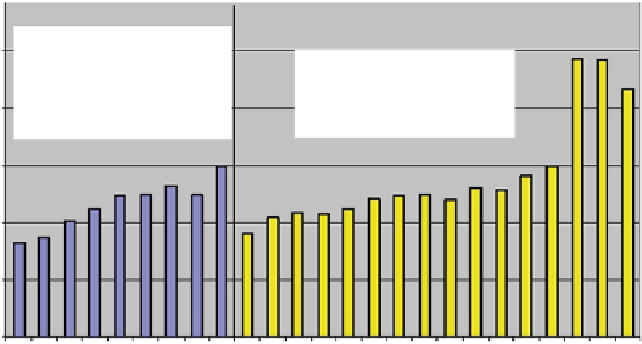Agriculture Reference
In-Depth Information
location Raguhn,
several experim. on 880 ha,
mean yield = 7.7 t / ha,
total N applied = 132 kg / ha
mean yield increase = 1.5%
115
several locations,
mean yield = 8.5 t / ha
total N applied = 170 kg / ha
mean yield increase = 4.1%
110
105
100
95
90
Fig. 9.40
Yields of winter-wheat in field experiments with site-specific nitrogen application via
the Kiel system of reflectance sensing versus uniform nitrogen fertilization. The results of uniform
nitrogen application are set to 100 %. The average nitrogen rates within each field with site-speciic
and with uniform application are about the same. The names below the columns represent the loca-
tions of the fields in Germany (From Werner et al.
2004
, altered)
Higher yields that are obtained with the same level of total nitrogen application
(Fig.
9.40
) indicate an improvement of mineral N use. However, it should be real-
ized that the
efficiency of N use
depends on the yield level. This is because of the
law of the diminishing returns (Mitscherlich
1922
; Holland and Schepers
2010
).
Hence a precise indication of the efficiency of N use can only be provided from
experiments in which the yields from uniform N fertilizing on the one hand and
from site-specific application on the other hand do not differ significantly. Such
results can be expected from experiments in which the N rate with site-specific
application is lower than with uniform fertilizing. The experiments that are listed in
Table
9.8
comply with this.
The site-specific control is either based on topography (Griepentrog and Kyhn
2000
), on reflectance sensing (Havrankova et al.
2008
) or on the resistance of the
canopy against bending (Thoele and Ehlert
2010
). It can be seen that all site-specific
methods improve the efficiency of nitrogen use (Table
9.8
). Especially the control
based on topography clearly enhances the nitrogen use. This suggests that in hilly
fields a combined control both by a surrogate for the nitrogen supply and in addition
via mapped topography might make sense.
A key question in this respect is whether site-specific nitrogen control should
aim at
higher yields
in masses of product per ha or at
lower expenditures
for

